Pop-Up Culture
At NeoCon 2016, held June 13-15 at the Merchandise Mart in Chicago, the International Interior Design Association (IIDA) unveiled IIDA Effect/Affect, an experiential space that encouraged tradeshow attendees to make their mark on the built environment by taking cards containing a “design fortune” and leaving business cards. The concept of “giving and taking” created a continuously evolving space that illustrated the impact of IIDA on the interior design industry and, in turn, the industry’s impact on the association.
Designed by the award-winning, San Francisco-based Studio O+A, led by IIDA International Board of Directors President-elect Primo Orpilla, FIIDA, and Verda Alexander, IIDA, IIDA Effect/Affect represented a departure from the association’s more traditional NeoCon booths of years past and exemplified a growing trend in commercial interior design—the rise of the pop-up space.
“A pop-up space is really meant to draw attention, make a statement, and be bold—that is what differentiates it from typical commercial spaces,” Alexander said. “Because the IIDA space at NeoCon was a small, short-term project, it was really easy to dive in, focus on a concept, and carry that concept through the design.”
Concepting and designing a pop-up can be challenging for commercial interior designers, but these spaces also provide them with new opportunities to push the boundaries presented by more permanent commercial spaces.
“I can look at materials that are more temporary and experimental and not have to think about something having a significant lifespan,” said Alexander, who has led the Studio O+A team on both retail and workspace pop-up projects. “As designers, we don’t need to think about longevity in a pop-up space. There’s a lot more freedom to be fashion forward, and it’s OK to be a bit trendy.”
Stephen Floyd, senior environmental designer at Herman Miller, agreed. “When approaching a temporary installation, you don’t have to predict the long-term needs of a permanent store or showroom. You can be more exploratory in your design approach. Rather than factoring in future adaptations or changing customer needs, you can design specifically for this moment and place in time,” he said.
But, according to Floyd, the possibilities aren’t endless. “Pop-ups aren’t all about design experimentation though. A significant constraint of designing a pop-up is that you are more subservient to the existing architecture and site conditions. You have to create a great brand expression within a non-branded volume of space,” he noted.
Regardless, pop-up spaces and shops have become a sought-after marketing tool for retailers as well as manufacturers, artists, restaurants, and workspaces. An opportunity to focus on concept and brand as well as the cost-effectiveness of these spaces due to the short-term investment in real estate have also made the pop-up a popular choice for companies eager to make a new and bold statement.
